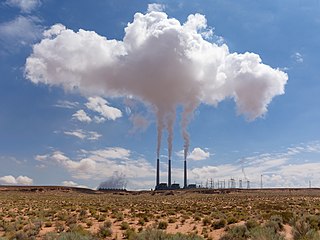
The Clean Water Act (CWA) is the primary federal law in the United States governing water pollution. Its objective is to restore and maintain the chemical, physical, and biological integrity of the nation's waters; recognizing the responsibilities of the states in addressing pollution and providing assistance to states to do so, including funding for publicly owned treatment works for the improvement of wastewater treatment; and maintaining the integrity of wetlands.
The National Emission Standards for Hazardous Air Pollutants (NESHAP) are air pollution standards issued by the United States Environmental Protection Agency (EPA). The standards, authorized by the Clean Air Act, are for pollutants not covered by the National Ambient Air Quality Standards (NAAQS) that may cause an increase in fatalities or in serious, irreversible, or incapacitating illness.
A State Implementation Plan (SIP) is a United States state plan for complying with the federal Clean Air Act, administered by the Environmental Protection Agency (EPA). The SIP, developed by a state agency and approved by EPA, consists of narrative, rules, technical documentation, and agreements that an individual state will use to control and clean up polluted areas.
Chevron U.S.A., Inc. v. Natural Resources Defense Council, Inc., 467 U.S. 837 (1984), was a landmark decision of the United States Supreme Court that set forth the legal test for when U.S. federal courts must defer to a government agency's interpretation of a law or statute. The decision articulated a doctrine known as "Chevron deference". Chevron deference consists of a two-part test that is deferential to government agencies: first, whether Congress has spoken directly to the precise issue at question, and second, "whether the agency's answer is based on a permissible construction of the statute."
Massachusetts v. Environmental Protection Agency, 549 U.S. 497 (2007), is a 5–4 U.S. Supreme Court case in which Massachusetts, along with eleven other states and several cities of the United States, represented by James Milkey, brought suit against the Environmental Protection Agency (EPA) represented by Gregory G. Garre to force the federal agency to regulate the emissions of carbon dioxide and other greenhouse gases (GHGs) that pollute the environment and contribute to climate change.
Whitman v. American Trucking Associations, Inc., 531 U.S. 457 (2001), was a case decided by the United States Supreme Court in which the Environmental Protection Agency's National Ambient Air Quality Standard (NAAQS) for regulating ozone and particulate matter was challenged by the American Trucking Association, along with other private companies and the states of Michigan, Ohio, and West Virginia.
A New Source Review (NSR) is a permitting process created by the US Congress in 1977 as part of a series of amendments to the Clean Air Act. The NSR process requires industry to undergo an Environmental Protection Agency pre-construction review for environmental controls if they propose either building new facilities or any modifications to existing facilities that would create a "significant increase" of a regulated pollutant. The legislation allowed "routine scheduled maintenance" to not be covered in the NSR process. Since the terms "significant increase" and "routine scheduled maintenance" were never precisely defined in legislation, they have become a source of contention in many lawsuits filed by the EPA, public interest groups, and utilities.

The Clean Air Act (CAA) is the United States' primary federal air quality law, intended to reduce and control air pollution nationwide. Initially enacted in 1963 and amended many times since, it is one of the United States' first and most influential modern environmental laws.

Air quality laws govern the emission of air pollutants into the atmosphere. A specialized subset of air quality laws regulate the quality of air inside buildings. Air quality laws are often designed specifically to protect human health by limiting or eliminating airborne pollutant concentrations. Other initiatives are designed to address broader ecological problems, such as limitations on chemicals that affect the ozone layer, and emissions trading programs to address acid rain or climate change. Regulatory efforts include identifying and categorising air pollutants, setting limits on acceptable emissions levels, and dictating necessary or appropriate mitigation technologies.

American Electric Power Company v. Connecticut, 564 U.S. 410 (2011), was a United States Supreme Court case in which the Court, in an 8–0 decision, held that corporations cannot be sued for greenhouse gas emissions (GHGs) under federal common law, primarily because the Clean Air Act (CAA) delegates the management of carbon dioxide and other GHG emissions to the Environmental Protection Agency (EPA). Brought to court in July 2004 in the Southern District of New York, this was the first global warming case based on a public nuisance claim.
Alaska Dept. of Environmental Conservation v. EPA, 540 U.S. 461 (2004), is a US Supreme Court case clarifying the scope of state environmental regulators and the Environmental Protection Agency (EPA). In a 5–4 decision, the Supreme Court found the EPA has authority to overrule state agency decisions under the Clean Air Act that a company is using the "best available controlling technology" to prevent pollution.
The United States Environmental Protection Agency (EPA) began regulating greenhouse gases (GHGs) under the Clean Air Act from mobile and stationary sources of air pollution for the first time on January 2, 2011. Standards for mobile sources have been established pursuant to Section 202 of the CAA, and GHGs from stationary sources are currently controlled under the authority of Part C of Title I of the Act. The basis for regulations was upheld in the United States Court of Appeals for the District of Columbia in June 2012.
Entergy Corp. v. Riverkeeper, Inc., 556 U.S. 208 (2009), is a decision by the United States Supreme Court that reviewed the Environmental Protection Agency's (EPA) interpretation of the Clean Water Act regulations with regard to cooling water intakes for power plants. Existing facilities are mandated to use the "Best Technology Available" to "minimize the adverse environmental impact." The issue was whether the agency may use a cost–benefit analysis (CBA) in choosing the Best Available Technology or (BAT) to meet the National Performance Standards (NPS).
Environmental Defense v. Duke Energy Corporation, 549 U.S. 561 (2007), is a United States Supreme Court case in which the Court held that while a term may be used more than once in a statute, an agency has the discretion to interpret each use of the term in a different way based on the context. It involved the Environmental Defense Fund and Duke Energy. In a unanimous decision, the court held in favor of the plaintiff's argument.
Utility Air Regulatory Group v. Environmental Protection Agency, 573 U.S. 302 (2014), was a US Supreme Court case regarding the Environmental Protection Agency's regulation of air pollution under the Clean Air Act.

The Clean Power Plan was an Obama administration policy aimed at combating anthropogenic climate change that was first proposed by the Environmental Protection Agency (EPA) in June 2014. The final version of the plan was unveiled by President Barack Obama on August 3, 2015. Each state was assigned an individual goal for reducing carbon emissions, which could be accomplished how they saw fit, but with the possibility of the EPA stepping in if the state refused to submit a plan. If every state met its target, the plan was projected to reduce carbon emissions from electricity generation 32% by 2030, relative to 2005 levels, as well as achieving various health benefits due to reduced air pollution.
County of Maui v. Hawaii Wildlife Fund, No. 18-260, 590 U.S. ___ (2020), was a United States Supreme Court case involving pollution discharges under the Clean Water Act (CWA). The case asked whether the Clean Water Act requires a permit when pollutants that originate from a non-point source can be traced to reach navigable waters through mechanisms such as groundwater transport. In a 6–3 decision, the Court ruled that such non-point discharges require a permit when they are the "functional equivalent of a direct discharge", a new test defined by the ruling. The decision vacated the ruling of the United States Court of Appeals for the Ninth Circuit, and remanded the case with instructions to apply the new standard to the lower courts with cooperation of the Environmental Protection Agency (EPA).
West Virginia v. Environmental Protection Agency, 597 U.S. ___ (2022), is a landmark decision of the U.S. Supreme Court relating to the Clean Air Act, and the extent to which the Environmental Protection Agency (EPA) can regulate carbon dioxide emissions related to climate change.
Sackett v. Environmental Protection Agency, 598 U.S. 651 (2023), also known as Sackett II, was a United States Supreme Court case related to the scope of the Clean Water Act.
The major questions doctrine is a principle of statutory interpretation applied in United States administrative law cases which states that courts will presume that Congress does not delegate to executive agencies issues of major political or economic significance.





